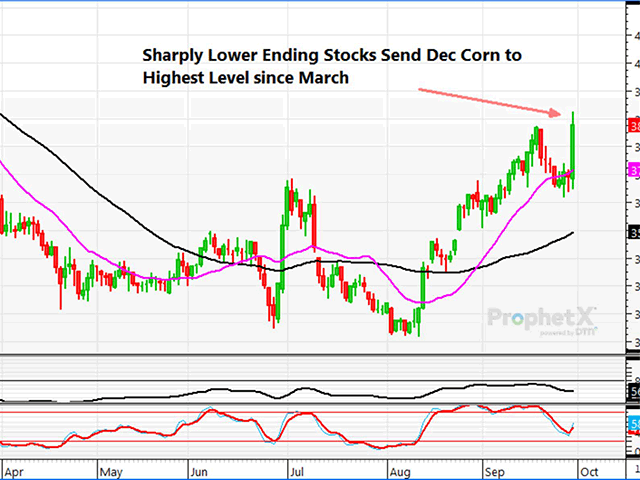USDA Reports Review
Bullish USDA Report Sends Corn, Wheat and Soy Futures Soaring
USDA's Sept. 1 Grain Stocks and Small Grains Summary reports, which many assumed would be mild reports, turned out to be a bullish surprise, playing right into the hands of long commodity funds. Sept. 1 corn stocks fell 10% from a year ago to just 1.995 billion bushels (bb), with soybean stocks, at 523 million bushels (mb), down 42% from a year ago. Wheat, with a mostly neutral to slightly friendly report, went along for the ride.
CORN
U.S. corn's Sept. 1 ending stocks were revealed at just 1.995 bb. According to the Dow Jones' pre-report survey, traders had expected ending stocks of 2.243 bb or 10 mb lower than the September World Agricultural Supply and Demand Estimates (WASDE) report. The actual stocks number was down 10% from September 2019, 258 mb lower than September 2020 and 248 mb below the average trade estimate.
The implication is likely higher feed and residual usage in the fourth quarter -- a bullish surprise in light of the reduced corn usage for ethanol as a result of COVID-19 restrictions. The June through August disappearance figured a hefty 3.028 bb.
On-farm corn stocks were 751 mb, down 8% from a year ago, while off-farm stocks figured 1.24 bb, down 12% from a year ago.
Only minor revisions occurred in the 2019-20 corn crop, with production being raised by 2.67 mb to 13.619 bb and yield being revised higher by 0.01 bushel per acre (bpa). Planted acreage ended up being 89.7 million acres (ma), with 81.3 ma of that harvested.
Corn, which was trading modestly lower ahead of the report, soared to new highs and closed 14 1/4 cents higher, as funds likely added to their growing net long. Managed funds were estimated to come into the report long, close to 70,000 contracts.
P[L1] D[0x0] M[300x250] OOP[F] ADUNIT[] T[]
SOYBEANS
Soybean stocks, expected to remain unchanged from the September USDA estimate of 575 mb, instead fell by 52 mb to 523 mb. That is down a huge 42% from last year's 909 mb ending stocks number.
Of the total stocks, only 141 mb of those were on-farm, while 382 mb were stored off-farm. On soybeans, the June-through-August disappearance figured to be 858 mb or down 2% from the same period a year ago.
Revisions to the 2019-20 soybean crop were also minor, with production lowered by 333,000 bushels, but yield left unchanged at 47.4 bpa and production amounting to 3.551 bb.
The further tightening of the U.S. soybean balance sheet, in light of huge China demand and drought in parts of Argentina and Brazil, made Wednesday's price reaction all the more volatile. Even without a further bump in exports due to China demand, it is very possible that U.S. ending stocks could be headed for 400 mb. Prior to the report, November beans were already nearly 10 cents higher, but finished with a daily gain of 30 1/2 cents per bushel, nearing the recent high.
The bullish stocks report played right into the hands of the managed money funds, estimated to begin the day with a combined soy complex long position of over 280,000 contracts. The trade will now turn its attention to harvest and yield, and to South American weather.
WHEAT
U.S. wheat stocks were expected to come in at 2.163 bb. The actual number turned out to be 2.159 bb. That is 187 mb lower than a year ago and the lowest September stocks since 2015 but was mostly a neutral number.
All-wheat production fell to 1.821 bb, about 14 mb less than trade expectations. Winter wheat production fell 27 mb to 1.17 bb, while spring wheat, at 586 mb, was raised 9 mb. White wheat figured 20 mb higher, while hard and soft red winter wheat were both lower than expected at 659 mb and 266 mb, respectively. Durum wheat, at 68.8 mb, was 28% higher than a year ago.
While the wheat production report may have been a bit friendly for hard and soft red wheat, overall, it was a neutral report. First-quarter feed and residual on wheat figured to be 215 mb, the largest in a few years.
Kansas City wheat futures, prior to the report, were up 15 cents per bushel, and the "any port in a storm" sympathy buying pulled KC to a closing gain of nearly 34 cents per bushel. Undoubtedly, wheat is trading more on weather, with drought in both Ukraine and Russia threatening to upend key export competitors.
CONCLUSION
With managed money funds holding their largest combined long position in over two years coming into the report, the bullish stocks report was music to fund managers' ears. Recently, longs had been punished, with soybeans 60 cents and corn 17 cents below recent highs. Both soybeans and wheat have been paying closer attention to developing drought situations in South America, along with Ukraine and Russia. With these reports out of the way, I suspect that the focus will now return to harvest yields and international weather.
December corn closed 14 1/4 cents higher at $3.79, November soybeans closed 30 1/2 cents higher at $10.23 1/2, Kansas City wheat finished 33 3/4 cents higher at $5.09 3/4, Chicago December wheat closed 28 1/2 cents higher at $5.78, and Minneapolis December closed 15 3/4 cents higher at $5.40 1/4.
Dana Mantini can be reached at dana.mantini@dtn.com
Follow Dana Mantini on Twitter @mantini_r
(c) Copyright 2020 DTN, LLC. All rights reserved.




